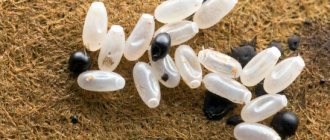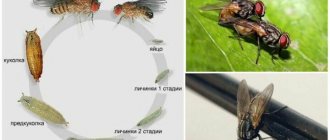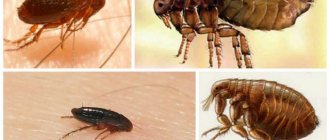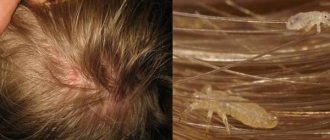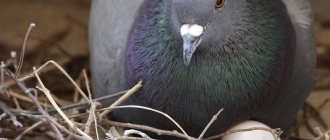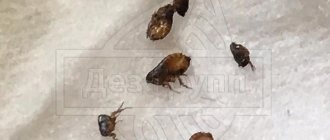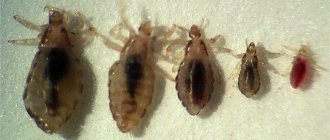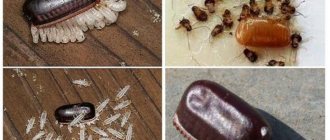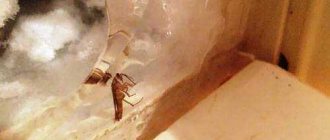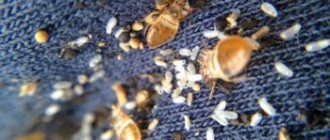Fleas belong to the order of blood-sucking insects. They can be called carriers of pathogens of various diseases that pose a danger to humans and animals.
Wingless insects have a highly specialized oral apparatus necessary for puncturing the skin of the victim and further sucking blood.
Being small in size, parasites are capable of jumping long distances. They often enter houses through basements, entrances, small cracks, and microcracks . Sometimes they can be found even in apartments where there are no pets. If the owner promptly discovered that his pet was suffering from parasites and removed them using special means, flea eggs may still remain in the house, which, under favorable conditions, subsequently become adults capable of leaving offspring.
What do flea larvae look like?
Often, many people, faced with the problem of removing fleas, are interested in what a flea egg looks like? In fact, since both humans and animals can be carriers of parasites, there are some differences that are very difficult to determine without special knowledge.
If we consider the color of a cat or dog flea egg, its shape and size, we can highlight the following features:
- oval shape;
- miniature size (up to 1 mm);
- White color.
The larvae of bloodsuckers that infect animals resemble tiny translucent worms that, after hatching from the egg, remain there until full maturity.
Anabiosis is possible because they do not require blood as food in this state.
Under a microscope, you can see that the entire body of the larva is covered with small hairs; there are no legs. Since the body is translucent and whitish in color, the esophagus with food digesting in it is clearly visible. The larva has a large head for its size with powerful jaws. This feature allows the larva to feed on the toughest food that it comes across.
Where do fleas live?
Strong, hardy and very tenacious, fleas are found on all continents, including Antarctica.
Most flea species live in temperate and subtropical climate zones of Europe, Asia and North Africa. Fleas are active at any time of the year, and their habitats are tied to the nests and burrows of warm-blooded animals living underground (gerbils, jerboas, gophers and other rodents), on the ground (wild and domestic animals: cats, dogs, rats, horses, cows , rams, camels, etc.) and above ground (birds, squirrels). Some fleas live on humans. The main hosts of most flea species are mammals, whose life at any time of the year is inextricably linked with the presence of shelter. Animals that periodically live in burrows and nests are less susceptible to flea attacks. Parasites do not live on the host’s body permanently, but jump on to suck blood and then descend into the nest’s litter. Some fleas are associated with artiodactyls and marsupials, which generally do not build or use nests and burrows. These types of fleas are stationary parasites that do not leave their hosts.
Fleas of both sexes suck blood, and the process can last from 1 minute to several hours. Fleas of some species are saturated with blood in reserve; as a result, they do not have time to digest everything, and the remaining blood is excreted in excrement.
Species of fleas that need frequent feeding live on the animal’s body constantly, and in between meals they wander in the fur of the owner. Fleas, which do not have the need to frequently suck blood, spend most of their lives in the substrate of the host's nest. In the absence of a food source, insects can starve for several months. Most flea species do not have a specific host choice and can exist on different animal species, with the exception of bat fleas.
How do they reproduce?
Despite the fact that fleas reproduce quickly, the process itself is quite complex and requires maintaining certain favorable conditions. The male has testes (2 pieces), ending with genital claws, through which the seed is transmitted to the female. The female has 2 or 4 ovaries, oviducts connecting at the body of the uterus, containing the spermatheca, located at the end of the abdomen in the form of a curved tube.
At the moment of mating, the female climbs onto the male’s back, after which she sucks up the sexually mature organ with the spermatheca. From the testes of a male to the body of a female flea, the seed travels on average about 10–15 minutes. While mating itself can last about a day.
After fertilization, the flea lays eggs in batches (4 to 10 pieces). Since the female needs strength for this, she must be satisfied with food before laying eggs. With normal saturation, a blood-sucking female is capable of laying eggs several times a day.
However, more often females lay one portion per day. Over the entire life cycle of a flea, it is capable of laying 500 eggs, which often infect a pet.
Due to the fact that insects place future offspring on the carrier in advance, subsequently the larvae can easily get enough food and grow quickly. In addition to animal fur, fleas leave clutches in places where they frequent.
The laying process is unique - the female throws eggs from her abdomen over a long distance. It is this method that ensures the vitality of the offspring, since they are at a distance and can eat normally without creating competition for each other.
Appearance of insects
Adult fleas look unusual. Their body is flattened on the sides. Each species has its own maximum body size. For one it is 1 mm, while others reach up to 5 mm. Females are most often larger and if they feed abundantly, they grow up to 1 cm. The shell around the body is dense and covered with many small bristles. Thanks to them, this pest is easily retained in the fur of warm-blooded animals, on the human body or in the feathers of birds. There are ridges on the head and chest, they run in teeth - these are ctenidia.
The eyes are simple, but the human eye cannot see them without magnification. Behind them are whiskers in the form of antennas, with which the insect explores the territory and looks for food. Then they hide in special whisker holes. There are 3 pairs of paws on the belly, they are strong. The flea jumps high. At the back is an organ that detects various vibrations in the air. Thanks to him, the insect can detect danger. The mouth is designed so that the female and male can pierce the skin and suck blood from the owner.
Where to look for them
Maturing individuals can be found not only in the fur of animals, but also in various places in the room or apartment where they live. They can be found in corners, crevices, microcracks in floors, behind baseboards, under wallpaper.
Formed bloodsuckers can settle in warm blankets, under the upholstery of upholstered furniture, and inside pillows. Since these insects are blood-sucking, feeding exclusively on blood, their habitat is limited to areas where a person or animal is often found. Thanks to this, they can always find food to survive.
The most likely habitats in which fleas live without an animal in an apartment are:
- sleeping places for pets;
- cracks behind the baseboards, in the floor;
- carpets, upholstered furniture, pile of toys;
- places with high humidity levels (under the bathtub, sink, shower).
Since the female parasite shoots her eggs in different directions when laying eggs, they can colonize any surface. And since the bedding of cats and dogs contains everything necessary for the full development of flea larvae, in addition to the animal’s fur, the flea larva feels comfortable in a sleeping place.
Habitats
The main condition for the parasite is the availability of food. Therefore, they can live in any environment where there is an opportunity to regularly feed and reproduce. These may be natural conditions or residential premises. The peculiarity of fleas is that in search of food they attack all warm-blooded animals, these can be dogs, cats, mice, rats and even birds. But if there are no animals nearby, they attack people and feed well on human blood.
If we talk about residential premises, they can be located in any hard-to-reach places. Most often, the accumulation of eggs is observed on the bedding of cats and dogs, in crevices and in the pile of carpets. Due to the fact that females do not lay eggs, but shoot their offspring, they can be found in absolutely any place.
Lifestyle and nutrition of future parasites
Flea larvae are not parasites, since they feed on decaying organic compounds, which make up particles of dead plants, excrement of formed fleas, containing undigested crusts of the victim's blood.
The larvae themselves do not feed on blood, therefore in this state they are harmless to humans and animals.
Maturation of the larvae lasts from 2 to 14 days. After this, the eggs hatch and small parasites continue to develop. The period of final maturation depends on environmental conditions; the more comfortable the larva feels, the faster the process of formation of the individual occurs.
If the ambient temperature is warm enough and there is a high level of humidity, the larvae will develop into an adult within a couple of days. An underdeveloped individual feeds on the feces of mature individuals, dried blood crust, and other layers of organic matter.
As the larva grows, it molts (3 times), after which it pupates like a butterfly. The time the larva remains in the cocoon ranges from several weeks to several months. It depends on the environmental conditions.
If they are unfavorable, the cocoon can remain unchanged for a year until the victim is in close proximity. According to scientists, even in the pupal state, a flea can smell blood. After emerging from the cocoon, the final stage of insect development begins.
Ways of infecting an animal with fleas
An animal can become infected with fleas in the following ways:
- In direct contact with a sick animal.
- Walking in the same places where a flea-infested dog walks. Larvae and adult fleas that have fallen from the fur of a sick pet can wait for their prey anywhere: in the grass, on paths and bushes. The jump of an adult reaches up to 40 cm in length and the same height. Therefore, when passing by the place where a flea is waiting, a healthy pet has practically no chance of not becoming infected with this parasite.
- It often happens that flea eggs and larvae get into the house, sticking to the soles of shoes.
- Our Jackusik once picked up fleas just by walking through the entrance. As it turned out, the insects lived in the basement of the house.
Do not forget that even if your beloved pet is completely free of fleas, there is a high probability of re-infestation if, in parallel with treatment of the dog, the places where it is most often found, in which flea larvae and eggs can live, are not treated for these blood-sucking insects: the bed, toys, rugs, upholstered furniture and so on.
Are they dangerous for humans?
Fleas and their larvae can be carriers of various serious diseases that pose a threat to human life:
- Bubonic plague;
- encephalitis;
- anthrax;
- trypanosomiasis;
- tularemia;
- typhus and relapsing fever, etc.
The likelihood of a threat may not be the norm, but a certain percentage remains. This is the most terrible threat to human health and life.
In addition, if you eat food without washing the eggs with your bare hands, you can become infected with various types of worms.
Danger to humans and animals
We all know how dangerous these parasites are for animals. The first thing that causes inconvenience to animals is the pain that comes from a flea bite. These insects do not produce enzymes that relieve pain when the skin is pierced. Therefore, a bite resembles a needle prick; when there are a lot of insects on the body, the animal feels quite severe pain.
But unfortunately, the torment does not end there. After a bite, the animal suffers from severe itching, which is simply impossible to tolerate, which leads to severe scratching and wounds. The skin becomes irritated and inflamed, and open wounds become an ideal place for infection to penetrate. If no action is taken, serious consequences arise.
Since these insects parasitize animals, many believe that they pose no danger to humans. This is a misconception, since fleas are among those insects that carry dangerous and even fatal diseases. These include encephalitis, plague, typhus, tularemia and others. Of course, not every flea is infected and carries diseases, but the possibility exists, which is very dangerous to health.
How to get rid of pests
Many, faced with this problem, wonder how to get rid of flea larvae? The first need when detecting insects on your beloved pet is to thoroughly clean the apartment.
The use of insecticidal drops and a flea collar for animals is not enough, since the laid eggs of parasites can remain in a state of suspended animation for a long time, and are activated when favorable conditions for life occur.
Treatment of premises against fleas and their eggs consists of several stages:
- carrying out general cleaning to get rid of eggs and parasite larvae as much as possible;
- spraying chemicals on furniture moved to the center and overturned, carpets infested with flea larvae. The most popular include Executioner, Cucarachi, Tetrix, Raptor, Combat;
- sealing the room for several hours (pets should also not be in the apartment during this entire time).
After the treatment has been carried out, it is necessary to ventilate the room well, beat the carpets outside, then vacuum them. In the warm season, some resort to airing and drying furniture, exposing it outside to the scorching rays of the sun.
This is explained by the fact that fleas and their larvae die at high temperatures. Therefore, in addition to chemical reagents, it is necessary to treat premises with high temperatures.
Ways of occurrence of fleas and symptoms
Fleas in cats are parasites that are most often found in the summer in animals that go outside. Their appearance in the fur requires an immediate reaction from the owner aimed at destruction. Such parasites are carriers of various diseases and pose a threat not only to cats, but also dangerous to humans, because they can also bite people.
If insects multiply heavily in your pet's fur, diseases such as anemia, weakened general immunity, and others are possible. As a result, every owner should know what fleas look like on cats, where they come from and the signs of parasites in a pet, and then think about how to get rid of them.
Ways of parasites appearing in domestic animals:
- accidental introduction of flea eggs or larvae from the street or from the entrance; according to statistics, 95% of these insects live in the basements of apartment buildings;
- from a neighboring apartment where there are infected pets;
- after contact with yard or wild dogs and cats.
Signs of fleas
Symptoms indicating the presence of fleas in a cat:
- the animal behaves restlessly, actively itches, tries to bite off parasites and licks itself;
- some cats become nervous due to constant itching;
- Living adult insects can be found among the undercoat;
- red dots appear on the skin at the sites of bites; if an infection occurs, they become inflamed and can develop into wounds, possibly causing dematitis;
- black dots are visible among the fur - flea excrement;
- Pests can be found in places where a cat cannot reach them: near the ears, in the armpits, on the back, chest and neck.
If you suspect that cats have fleas, you should carefully examine the fur for the presence of black spots of digested blood. Flea feces, when rubbed with your fingers, are separated into small particles that are clearly visible among the hairs. If the undercoat is short, the animal combs it onto the floor, where it can become food for the larvae.
Prevention
To destroy the pest, it is necessary to use special drops (with fipronil, selamectin, metaflumizone), which are dripped between the shoulder blades, sprays, oral medications (tablets, suspensions, etc.), shampoos or collars.
It is best to first treat the affected Murka with an external remedy, and then secure the result with a collar or oral medication.
Important! Collars containing products such as permethrin (deadly), amitraz, or organophosphates should not be used on cats. Next, you need to comb out all the insects and their eggs from the wool using a comb with thicker teeth.
Don't forget to treat your apartment with insecticides: especially old furniture, closets and cracks on the floor. But it is better to call a special service for these purposes. This way you will neutralize their breeding sites, and also destroy pupae and larvae
Next, you need to comb out all the insects and their eggs from the wool using a comb with thicker teeth. Don't forget to treat your apartment with insecticides: especially old furniture, closets and cracks on the floor. But it is better to call a special service for these purposes. This way you will neutralize their breeding sites, and also destroy pupae and larvae.
Next, you can support your pet with vitamins or medications with sulfur (if anemia appears) and treat the affected skin with ointments.
Fleas are not only unpleasant itching and bites, but also a threat to your pet’s health. Therefore, try to examine his coat as often as possible and apply parasite control measures immediately.
How to remove lice from a cat. Treatment methods
To solve the problem of lice infestation in cats, special insectoacaricidal preparations are used. When using them, it is important to strictly follow the instructions for use. Be sure to read all contraindications to avoid side effects.
To treat lice in cats use:
- Drops on the withers. Drops are applied at the base of the skull or along the spine. The procedure takes only a few minutes. The drug usually not only helps get rid of existing lice in a cat, but also helps protect the pet from new attacks by parasites.
- Sprays. The spray moisturizes the animal's fur. During such processing, maximum care must be taken to avoid harm to the animal. After applying the product, wait until it dries and make sure that the animal does not lick it off. For this purpose, it is recommended to wear a protective collar. Sprays are also used to kill parasites indoors and in animal resting places (houses, sofas, armchairs).
Reproduction of fleas at home
Insects have a well-developed reproductive function. A flea colony multiplies rapidly in comfortable living conditions. One female lays 350–450 eggs during her life.
Flea reproduction (photo)
Fleas literally squeeze eggs out of themselves, scattering them throughout their habitat. Therefore, you can find small larvae that look like tiny grains of rice in any corner of the apartment. After hatching, the flea looks like a worm with bristles. After two weeks it turns into an adult, moults 3 times, and feeds on the dried droppings of adults.
Note! A flea infestation can be determined by painful bites on the skin. The affected area develops noticeable and painful redness, accompanied by severe itching. There is compaction in the center. One individual bites a person 3–5 times in a couple of seconds.
Identifying Dog Fleas
You should periodically check your pet for parasites. And, of course, dog fleas will immediately make themselves felt. To do this, the dog needs to be placed on a white cloth or paper and scratched, after which the crumbled blood and excrement will be noticeable. If you wet them with water and brown spots appear, you can be sure that the animal has fleas.
In addition, the dog will be in an agitated state due to painful flea bites. He can also become quite inattentive, scratching himself all the time. Various infections can get into the wounds formed at the site of bites. Therefore, if a dog shows signs of itching, lack of appetite, weight loss, nervous condition, poor concentration, then you urgently need to save the animal.
From eggs to larvae
Over the entire period of its existence, the flea goes through several stages of development: from egg to larva, from larva to pupa, from pupa to adult insect. The eggs are laid by the female on the animal's fur or in its habitat. One flea can lay up to twenty-five of them per day, and throughout its life - up to six hundred. Sometimes eggs, like grains of salt, cover the animal's body, which contributes to their scattering everywhere.
After some time, the larvae are born. At this stage, their appearance is completely different and different from what a flea looks like as an adult. The food of the larvae consists of any organic matter, including the feces of adults. And in the absence of such food, they can eat each other. The larvae live together with the owner, so they are most often found on the animal’s rug, in genital crevices, in basements, etc.
Pupa and adult
The further stage of flea development is the transformation from larva to pupa. In this form they can be stored for a year, tolerating cold weather quite well. After a certain period, due to warm weather or the presence of a warm-blooded animal, adult fleas emerge from the pupae. Under normal conditions, their full development cycle occurs in three to four weeks.
